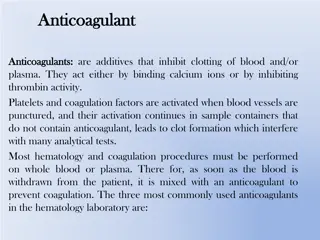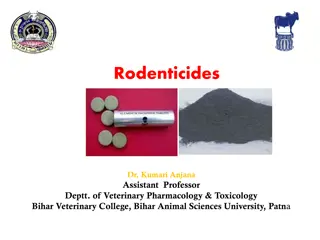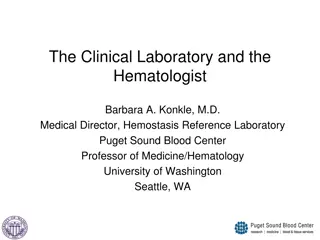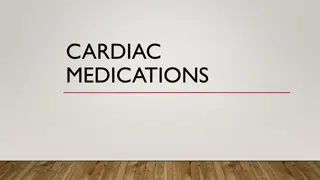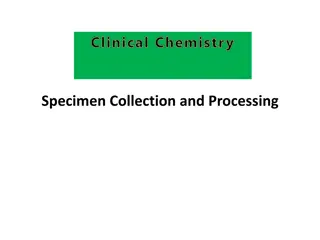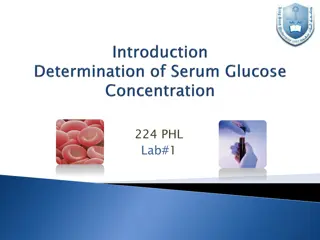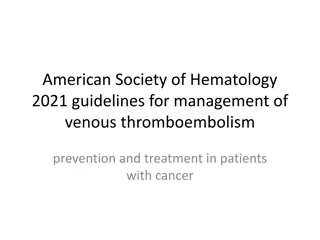Understanding Anticoagulants Used in Hematology Laboratory
Anticoagulants play a crucial role in hematology by preventing blood clotting, allowing separation of blood components, with EDTA being the most commonly used anticoagulant. Proper blood-to-anticoagulant ratio is essential to avoid inaccuracies in results, such as falsely reduced hematocrit or erroneously high platelet counts. It is vital to understand the effects of anticoagulants to ensure accurate hematological testing.
Download Presentation

Please find below an Image/Link to download the presentation.
The content on the website is provided AS IS for your information and personal use only. It may not be sold, licensed, or shared on other websites without obtaining consent from the author. Download presentation by click this link. If you encounter any issues during the download, it is possible that the publisher has removed the file from their server.
E N D
Presentation Transcript
Anticoagulant used in Hematology Dr Versha Prasad
Anticoagulants Used In the Hematology Laboratory Anticoagulants are defined as substances which prevent blood clotting / coagulation, and allow separation of the blood into cellular and liquid (plasma) components. Generally plasma contains coagulation factors.
The three anticoagulants commonly used in hematology laboratory are: 1] Ethylene Di-Amine Tetra-Acetic Acid (EDTA): EDTA can be found in three salt forms: 1- Tri-Potassium EDTA 2- Di-Sodium EDTA 3- Di-Lithium EDTA Generally tri-Potassium EDTA is better than di- Sodium EDTA and di- Lithium EDTA.
EDTA Also, EDTA can be crystalline or liquid. Liquid EDTA tubes require specific filling volume to avoid dilution effect. So, blood: anticoagulant ratio must be maintained (this is applicable to all anticoagulants). EDTA is also known as Versene or Sequestrene. EDTA acts by chelating / removing ionized calcium (calcium is required for blood to clot, so when it is removed blood will not clot).
EDTA EDTA is the most commonly used anticoagulant in the hematology laboratory, and is the anticoagulant of choice for the CBC. Excess EDTA (i.e. more EDTA, you fill less blood volume, so EDTA is in excess), causes shrinkage of RBC s, causing falsely / erroneously reduced hematocrit (HCT), and subsequent increase in MCHC and decrease in MCV (MCV and MCHC are RBC indices that will be studied later).
EDTA Platelets are also affected, they will swell and subsequently disintegrate, causing erroneously high platelet count, since platelets will be disintegrated into more than one fragment, each fragment will be counted as one platelet (for example if one platelet will be disintegrated into 4 fragments, the 4 fragments will be counted as 4 platelets, but actually they represent one platelet, causing erroneously high platelet count). From the previous discussion we conclude that correct ratio of blood to anticoagulant is very important, to rule out these in vitro effects.
EDTA EDTA can induce platelet aggregation and clumping, causing falsely decreased platelet count, because these platelet clumps will not be counted as platelets, they may counted as red blood cells (causing low platelet count and high red blood cells counts). This technical problem can be solved by (1) repeated measurements, (2) extraction of new sample and repeat measurements, (3) study the automated cell histograms, and (4) by visualizing blood film, looking for these platelet clumps. Also, Aggregated and clumped platelets interferes with WBC counting zone in automated hematology counters that use electrical impedance technology
2. Sodium Citrate Is the anticoagulant of choice for coagulation and platelet function tests, also is used for ESR (erythrocyte sedimentation rate test). It acts by precipitating calcium, thus it will not be available for clotting process. It came in a liquid form, as 3.8% tri-sodium citrate. For coagulation testing, the ratio of 9 volumes of blood to one volume of anticoagulant (9 volumes blood: 1 volume anticoagulant) is very critical (very important), as variation from this ratio may cause errors. For ESR (4) volumes of blood to one volume of anticoagulant is used (4: 1). Generally, this anticoagulant is not suitable for routine hematology testing. From this we conclude that sodium citrate acts as anticoagulant and as diluent (as in the case of ESR). Because of its dilution effect it can t be used for CBC.
3. Heparin Heparin is an acid mucopolysaccharide, it acts by complexing with anti-thrombin to prevent blood clotting (antithrombin is one of the natural/physiological inhibitors of blood coagulation, which is found in vivo). It is not suitable for blood films staining, since it gives too blue coloration to the background, when films are stained with Romanovsky stains, also, heparin may cause leukocyte and platelet clumping , this is why heparin is not suitable for routine hematology tests. It is the preferred anticoagulant for osmotic fragility test. Heparin also is used in capillary
Heparin tubes for spun hematocrit (HCT) (heparin cover the entire capillary tube glass), these capillary tubes are also called microhematocrit capillary tubes. Heparin is also used for L.E. cell preparation (L.E.= Lupus Erythromatosus). 1. Heparin is found in basophil and mast cell granules. 2. Heparin is used therapeutically as an in vivo anticoagulant








